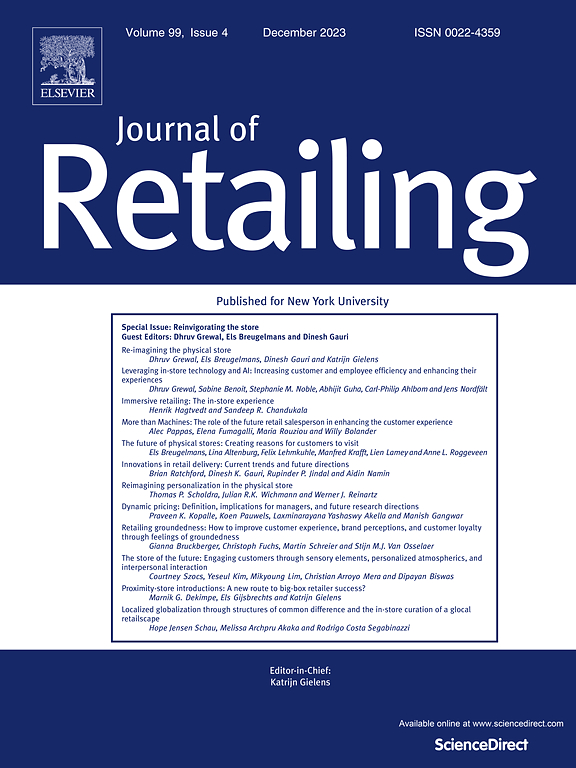统一还是区别:多渠道零售商的价格竞争策略
IF 10.2
1区 管理学
Q1 BUSINESS
引用次数: 0
摘要
多渠道零售商面临着一个至关重要的决定,即是否在线上和线下收取相同的价格。为了研究竞争性定价策略,我们构建了一个双垄断模型,该模型包含两个多渠道零售商,其中消费者的品牌偏好是异质的。此外,消费者对产品的熟悉程度不同,并被分为知情和不知情两类。虽然知情的消费者知道理想的产品变体,但不知情的消费者可能会购买不合适的变体并随后退货,这对他们自己和零售商都产生了退货成本。因此,零售商提供商店协助,帮助不知情的消费者找到他们匹配的产品。我们的分析表明,均衡定价结构受到两种效应的影响:当零售商的门店辅助成本有效时,渠道效率效应推动零售商采用统一定价;当消费者表现出较弱的品牌偏好和统一定价时,竞争效应推动零售商采用双重定价。这些影响的相互作用导致对称和不对称定价均衡。特别是,当渠道效率效应有利于统一定价且竞争效应显著时,就会出现价格不对称均衡,在这种不对称均衡下,统一定价零售商可以通过提供低于竞争对手线上线下价格的统一价格来胜过其双重定价竞争对手。本文章由计算机程序翻译,如有差异,请以英文原文为准。
Unifying or discriminating: Competitive pricing strategies for multi-channel retailers
Multi-channel retailers face a crucial decision of whether to charge the same price online and offline. To examine the competitive pricing strategy, we construct a duopoly model with two multi-channel retailers for which consumers are heterogeneous in their brand preferences. Additionally, consumers have heterogeneous product familiarity and are categorized into informed and uninformed segments. While informed consumers are aware of desirable product variants, uninformed consumers may purchase unfit variants and subsequently return them, which incurs return costs for both themselves and the retailer. Therefore, retailers offer store assistance to help uninformed consumers find their matching products. Our analysis reveals that the equilibrium pricing structure is influenced by two effects: the channel-efficiency effect drives the adoption of uniform pricing when a retailer’s store assistance cost is efficient, while the competition effect drives dual pricing when consumers exhibit weak brand preferences and uniform pricing otherwise. The interaction of these effects leads to both symmetric and asymmetric pricing equilibria. In particular, an asymmetric pricing equilibrium emerges when the channel-efficiency effect favors uniform pricing and the competition effect is significant, and at this asymmetric equilibrium, the uniform pricing retailer can outperform its dual pricing rival by offering a uniform price lower than the online and offline prices of the rival.
求助全文
通过发布文献求助,成功后即可免费获取论文全文。
去求助
来源期刊

Journal of Retailing
BUSINESS-
CiteScore
15.90
自引率
6.00%
发文量
54
审稿时长
67 days
期刊介绍:
The focus of The Journal of Retailing is to advance knowledge and its practical application in the field of retailing. This includes various aspects such as retail management, evolution, and current theories. The journal covers both products and services in retail, supply chains and distribution channels that serve retailers, relationships between retailers and supply chain members, and direct marketing as well as emerging electronic markets for households. Articles published in the journal may take an economic or behavioral approach, but all are based on rigorous analysis and a deep understanding of relevant theories and existing literature. Empirical research follows the scientific method, employing modern sampling procedures and statistical analysis.
 求助内容:
求助内容: 应助结果提醒方式:
应助结果提醒方式:


